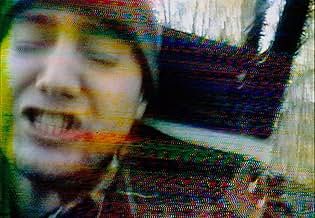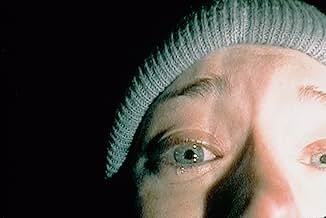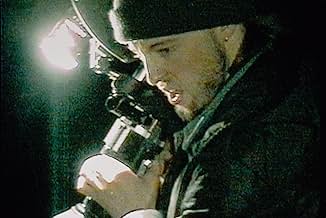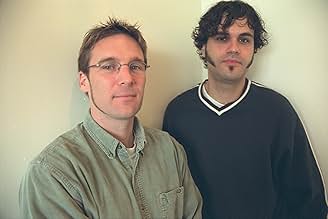Drei Filmstudenten verschwinden, nachdem sie in einen Wald von Maryland gereist sind, um einen Dokumentarfilm über die lokale Blair Hexenlegende zu drehen, wobei sie nur ihr Filmmaterial zur... Alles lesenDrei Filmstudenten verschwinden, nachdem sie in einen Wald von Maryland gereist sind, um einen Dokumentarfilm über die lokale Blair Hexenlegende zu drehen, wobei sie nur ihr Filmmaterial zurücklassen.Drei Filmstudenten verschwinden, nachdem sie in einen Wald von Maryland gereist sind, um einen Dokumentarfilm über die lokale Blair Hexenlegende zu drehen, wobei sie nur ihr Filmmaterial zurücklassen.
- Auszeichnungen
- 23 Gewinne & 26 Nominierungen insgesamt
- Michael Williams
- (as Michael Williams)
- Waitress
- (as Sandra Sanchez)
- Interviewee with Child
- (as Jackie Hallex)
Handlung
WUSSTEST DU SCHON:
- Wissenswertes(at around 46 mins) In a scene where the main actors are sleeping in a tent at night, the tent suddenly shakes violently and they all get scared. This was unscripted and the director shook the tent; the actors actually were scared.
- PatzerThe three are lost in the woods but in one scene, about 25 feet behind them, a field can be seen through a small gap in the trees. The road is also visible as they try to find the trail.
- Zitate
Heather Donahue: I just want to apologize to Mike's mom, Josh's mom, and my mom. And I'm sorry to everyone. I was very naive. I am so so sorry for everything that has happened. Because in spite of what Mike says now, it is my fault. Because it was my project and I insisted. I insisted on everything. I insisted that we weren't lost. I insisted that we keep going. I insisted that we walk south. Everything had to be my way. And this is where we've ended up and it's all because of me that we're here now - hungry, cold, and hunted. I love you mom, dad. I am so sorry. What is that? I'm scared to close my eyes, I'm scared to open them! We're gonna die out here!
- Crazy CreditsThe beginning and end credits are designed in the style of a documentary, e.g. jumping slightly, static instead of rolling credits.
- Alternative VersionenIn October 2001, the FX Network aired this with "never-before-seen footage". This turned out to be a few segments spliced into the closing credits of Heather videotaping Mike saying goodbye to his friends and family, and Heather admitting culpability for the week's occurrences. Mike firmly states that it is not her fault, which is referenced in Heather's later confession to the camera in the theatrical version. Also, all profanities are overdubbed, especially a really bad "let's go" over Heather saying "f**k you" to Josh as he berates her about being lost and hunted on the dusk before he is taken away.
The first section of the film appears at first to be amateurish and slow. In fact, it is very deft, and very efficient at what it does. It tells the audience everything it needs to know about the characters and situation, and nothing more. Also, it gets the audience into the habit of viewing the film's format: alternating between black and white (very grainy and poorly focussed) film, and the washed out colours of shaky pixilated video. The film makers managed to set up a rationale for why the film is so cheaply made. Three people hike into the woods for a few days to shoot a documentary, with borrowed equipment, and are in the habit of videoing everything for the hell of it. They cannot carry tripods, steadicams, dollies, large lighting rigs, or the like, so everything we see is lit either by raw daylight, or by a single light fixed to the camera, which illuminates just what is within a few feet of the lens. The film creates its own excuse to be cheap. This is intelligent.
The acting and script are both excellent. The well-cast actors are presumably playing pretty-much themselves, and are convincingly naturalistic, and neither too likeable or too dislikeable. The slow route into hysteria is well documented. Rather than simply having a character say "We're lost!", we see many scenes which show the trio getting more and more hopelessly lost, and more annoyed with each other for this. By the time they are thoroughly lost, the audience shares the despair.
My friend and I, after seeing it, both felt a little sick. I put this down to my having been tense for a hour, he put it down more to motion sickness. The jerky, badly-framed camerawork is hard on the eye and stomach, but I applaud the director for its uncompromising use. Similarly, no compromise is made with the dialogue. Some of it is very quiet and must be listened for, some is technical jargon, which is left realisticly unexplained.
One of the great strengths and weaknesses of the film is the editing. It is good in that it does much to heighten the tension, with many key moments lasting just a little too long for comfort. Each time the characters find something nasty, the viewer is made to want the editor to cut soon to the next scene, and the fact that he doesn't adds to the sense of being trapped, as the characters are. The problem with this, though, is that one is left wondering about the motives of the fictional editor. In truth, of course, the film is edited to create these effects, and to entertain, but the film's rationale is that these are the rushes of a documentary put together posthumously by someone other than the film's original creator. Why, then, would an editor piecing together such footage, edit for dramatic effect rather than for clarity? Why would he keep cutting back and forth from the video footage to the film footage, when neither shows any more information than the other?
The film is stark. After one simple caption at the start, all that follows is the "rushes". I wonder if the film might not have been improved with an introductory section which documented how the rushes were found and edited. A programme was made for television which did this. Perhaps a portion of this might have been added to the film, making it more complete, and more believable (and proper feature length).
While I applaud the fact that young original film-makers have managed to create a mainstream hit out of a simple idea, well-handled. I dread the possible avalanche of inferior copies which may come.
Most horror films these days are created not for the audience, but for the makers. The departments of special effects, make-up, model-making, animation and so forth all try hard to show potential future employers what they can do. The result is that nothing is left for the audience to do, since everything can be seen and heard, and the viewer's imagination can be switched off. Today, it is possible to see pigs fly on the screen, and so film-makers show off and show us a formation of Tamworths, which is something which will look impressive in the trailer. To show us less is to make our minds fill in the gaps. This way, we create our own terrors, perfectly fitted to ourselves. The ghastly face I see in my head, is the ghastly head which I find scary. The ghastly face I am shown may be one I can cope with quite easily. If I see a believable character screaming in hysterical fear at something I cannot see, my own brain creates demons for my night's dreams, demons far more mighty than anything CGI graphics or a latex mask could portray.
This film will stay in your thoughts for some while.
Top-Auswahl
Details
- Erscheinungsdatum
- Herkunftsland
- Offizieller Standort
- Sprache
- Auch bekannt als
- El proyecto de la bruja de Blair
- Drehorte
- Patapsco Valley State Park - 8020 Baltimore National Pike, Ellicott City, Maryland, USA(house in final scene)
- Produktionsfirma
- Weitere beteiligte Unternehmen bei IMDbPro anzeigen
Box Office
- Budget
- 60.000 $ (geschätzt)
- Bruttoertrag in den USA und Kanada
- 140.539.099 $
- Eröffnungswochenende in den USA und in Kanada
- 1.512.054 $
- 18. Juli 1999
- Weltweiter Bruttoertrag
- 248.639.099 $
- Laufzeit1 Stunde 21 Minuten
- Farbe
- Sound-Mix
- Seitenverhältnis
- 1.33 : 1
















![[Rec]](https://m.media-amazon.com/images/M/MV5BMzQ1MzU0NTAtOWYyMi00NmJkLWJmYWMtYjc1N2ZhYWZmM2JiXkEyXkFqcGc@._V1_QL75_UX140_CR0)








